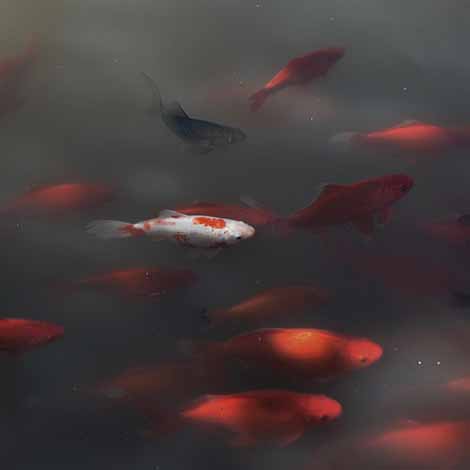All ponds are subject to evaporative water loss driven by heat, wind, and low humidity. As the water evaporates, suspended organics stay behind and concentrate, diminishing water quality and contributing to algae blooms.
Adding water regularly to replenish what’s evaporated is important, but it does nothing to remove the concentrated pollutants in your pond. We recommend partial or complete pond water changes to freshen your koi pond or water garden for your finned friends.
Here are five reasons why pond water changes are so vital for your fish and plant wellness:
- Remove Excess Nutrients
Fish waste, decaying vegetation, and leftover fish food are nutrient-rich organics that contribute to muck, algae, and debris buildup. Changing fish pond water removes these excess nutrients and chemicals like nitrates, phosphates, and ammonia that can harm aquatic life in high concentrations. - Promote Fish Health
Fish cannot thrive in stagnant, murky pond water where contaminants and pathogens run amuck. Adequate filtration is essential for reducing the risk of fish diseases, but it’s not always enough, especially if an active infection already threatens your fish population.
Koi pond water changes are necessary for successfully treating sick fish and preventing reinfection. Regular water cycling removes filth, introduces clean water, improves water quality, and promotes fish wellness. - Control Algae Blooms
Having some algae is vital to a balanced pond ecosystem, but too much can block sunlight and reduce oxygen levels. Pond water changes control algal overgrowth by decreasing both the algae population and the carbon dioxide and nutritious minerals they need to survive and reproduce. - Fight Pond Foam
Foam forms when excess organic material has accumulated in your water garden. When this nutrient-laden water pours down your waterfall, the air and water collide, causing the proteins and other organics to be trapped inside bubbles rather than turning into ammonia and nitrites. A water change will quickly reduce that foamy buildup. - Maintain Water Clarity and pH Stability
A water change will also improve the appearance of cloudy water and reset pH levels, resulting in a pristine pond filled with happy fish, lush greenery, and clear water.
When and How to Do a Pond Water Change
To reduce stress and illness among your fish, we recommend routine partial water changes during spring start-up when water temperatures reach 50° Fahrenheit. You may need to cycle pond water more frequently throughout the season to combat fish diseases, cloudy water, or algae blooms.
Follow the simple instructions outlined in our How to Drain a Pond Guide to perform a pond water change. You will need a pond drain pump with a filter—or a heavy-duty pond vacuum—for the fastest cleanout and water cycling.
Ensure you add Stress Reducer Plus and Nature's Defense every time you change pond water. Stress Reducer Plus forms a beneficial slime coat on your fish and makes tap water safe by removing chlorine, chloramines, and heavy metals. Nature's Defense beneficial bacteria and enzyme blend digests organics in the pond and further reduces ammonia, phosphates, and nitrogen.
Questions About Pond Water Changes
Do you need to do a water change in your pond but still have questions? We are here to help! Contact a pond expert at 866-766-3435 and explore these additional pond water maintenance guides below:
Find and Fix a Leak
How to Clear Brown Pond Water
Algae After Pond Cleanout
Quick Spring Cleanouts
Understanding the Nitrogen Cycle
Last Updated: March 8, 2024
